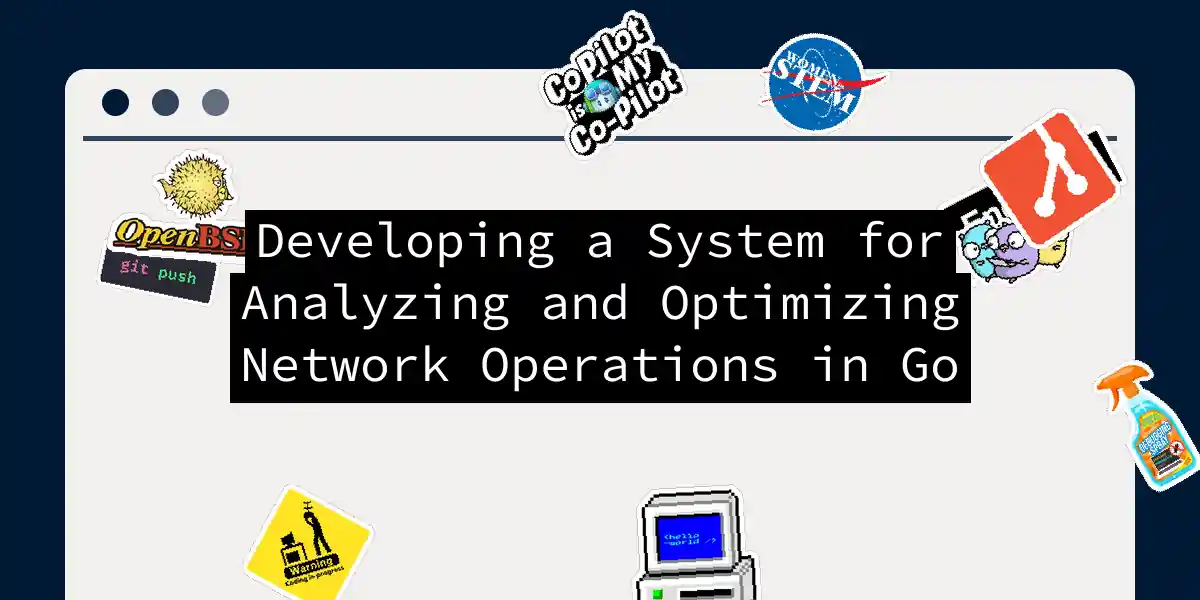When it comes to developing high-performance network operations in Go, the journey can be as thrilling as a treasure hunt, but instead of a treasure map, you’re armed with benchmarks, profiles, and a keen eye for optimization. In this article, we’ll delve into the practical steps and strategies for analyzing and optimizing network operations in Go, making sure your services run as smoothly as a well-oiled machine.
Setting the Stage: Benchmarking and Profiling
Before you embark on any optimization journey, it’s crucial to establish a baseline for comparison. This is where benchmarking comes into play. Benchmarking in Go is straightforward and highly effective, thanks to the built-in testing package.
package main
import (
"testing"
)
func BenchmarkNetworkOperation(b *testing.B) {
// Your network operation code here
for i := 0; i < b.N; i++ {
// Simulate network operation
// For example:
// net.Dial("tcp", "example.com:80")
}
}
To run your benchmarks, use the following command:
go test -bench=. -benchmem -benchtime=10s
This will give you a clear picture of how your network operations are performing. However, benchmarks alone might not be enough; you need to profile your application to understand where the bottlenecks are.
go test -bench=. -benchmem -benchtime=10s -cpuprofile cpu.out -memprofile mem.out
You can then use pprof to analyze these profiles:
go tool pprof cpu.out
Optimizing Memory Allocation and Garbage Collection
One of the most significant performance killers in Go can be excessive memory allocation and garbage collection. Here are a few strategies to mitigate this:
Avoiding Pointers and Reducing GC Overhead
Pointers can significantly increase the workload of the garbage collector. Here’s an example of how you can optimize a simple hash function by avoiding pointers:
// Before optimization
type IntHash map[string]int
func (h IntHash) Get(key string) int {
return h[key]
}
// After optimization
type IntHash map[int]int
func (h IntHash) Get(key int) int {
return h[key]
}
By converting string keys to integers before storing them in the map, you reduce the number of pointers and thus the GC overhead.
Reusing Slices and Avoiding Unnecessary Allocations
Slices in Go can be reused to avoid unnecessary allocations. Here’s how you can modify a function to reuse slices instead of creating new ones:
func processSlice(data []byte) []byte {
// Before optimization
// return append([]byte{}, data...)
// After optimization
result := make([]byte, len(data))
copy(result, data)
return result
}
This approach ensures that you are not creating a new slice on each function call, which can significantly reduce memory allocation and GC overhead.
Optimizing Network Operations
Network operations can be optimized in several ways:
Using Efficient Data Structures
Using efficient data structures can significantly improve the performance of your network operations. For example, using a sync.Pool to reuse buffers can reduce memory allocation and GC overhead.
var bufferPool = sync.Pool{
New: func() interface{} {
return make([]byte, 1024)
},
}
func processNetworkData(data []byte) {
buf := bufferPool.Get().([]byte)
// Use the buffer
bufferPool.Put(buf)
}
Minimizing Context Switches
Context switches can be costly in network operations. Minimizing these switches by using asynchronous I/O and goroutines can improve performance.
func handleConnection(conn net.Conn) {
go func() {
// Handle read operations
buf := make([]byte, 1024)
for {
n, err := conn.Read(buf)
if err != nil {
return
}
// Process the data
}
}()
go func() {
// Handle write operations
for {
// Write data to the connection
}
}()
}
Using Contexts for Transaction Management
When dealing with network operations that involve transactions, using contexts can be highly beneficial. Here’s an example of how you can use contexts to manage transactions in a distributed system:
type TransactionContext struct {
ctx context.Context
tx *sql.Tx
}
func NewTransactionContext(ctx context.Context, db *sql.DB) (*TransactionContext, error) {
tx, err := db.BeginTx(ctx, nil)
if err != nil {
return nil, err
}
return &TransactionContext{ctx, tx}, nil
}
func (tc *TransactionContext) Commit() error {
return tc.tx.Commit()
}
func (tc *TransactionContext) Rollback() error {
return tc.tx.Rollback()
}
This approach ensures that transactions are managed transparently and efficiently across different components of your system.
Monitoring and Logging
Monitoring and logging are crucial for maintaining high-performance network operations. Using tools like Prometheus for monitoring and logging can help you identify bottlenecks and optimize your system in real-time.
Conclusion
Optimizing network operations in Go is a multifaceted task that involves benchmarking, profiling, optimizing memory allocation, and using efficient data structures and transaction management techniques. By following these steps and using the right tools, you can ensure that your network operations run efficiently and reliably.
Remember, optimization is an ongoing process. Continuously monitor your system, and be ready to make adjustments as needed. With the right approach and tools, you can turn your Go application into a high-performance powerhouse that handles network operations with ease.
